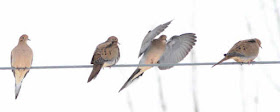 |
| Pair of Mourning Doves on the snow at the Montezuma Audubon Center |
I call them "bobble-heads" because of the way their heads bob as they walk across the ground in search of seeds dropped by other birds from the hanging feeders. Small buffy head, large buff-colored body, darker gray-brown on the wings and back, dark spots on folded wings, long-pointed tail with white along the edges… They prefer to feed on the ground, usually in small flocks, but if there’s enough room they’ll land on a platform feeder. When they take off, the whistling of the wings is diagnostic. In the morning, flocks try to catch the early rays of sunlight by lining up on utility wires strung between poles along country roads. We are of course talking about Mourning Doves (Zenaida macroura), named for their sorrowful cooing sometimes mistaken for the call of an owl.
Doves are the preferred prey of the Cooper’s Hawk, that long-tailed, short-winged, fast and maneuverable accipiter that visits our bird feeders.
The doves, related to domestic pigeons, are mainly vegetarian. You may see a flock picking up waste grain in a winter cornfield if there’s not much snow, but they also eat seeds from grasses and weeds. A few insects are fed to nestlings during the warm months. In late summer they eat the dark-purple, almost black, berries of pokeweed. Many doves head south to agricultural areas for the winter, and a few birds banded in New York have gone as far as the Gulf-coast states.
The doves, related to domestic pigeons, are mainly vegetarian. You may see a flock picking up waste grain in a winter cornfield if there’s not much snow, but they also eat seeds from grasses and weeds. A few insects are fed to nestlings during the warm months. In late summer they eat the dark-purple, almost black, berries of pokeweed. Many doves head south to agricultural areas for the winter, and a few birds banded in New York have gone as far as the Gulf-coast states.
In early spring, watch for them to begin pairing up as they prepare for a long nesting season, and listen for their "song," a series of five coos with the second one rising and falling. Once they set up housekeeping, a skimpy handful of loose twigs barely qualifies as a nest and it looks like the eggs are in danger of falling through or rolling off. Mourning Doves nest repeatedly through the summer, and I’ve seen them sitting on eggs as late as October in New York. That particular nest, in one of our spruce trees, may have been the fourth brood of the year. It’s a good thing, because half the chicks don’t make it out of the nest; they fall victim to various predators, both avian and mammalian. Of the half that survive the nest and fledge, three-quarters don’t make it to their first birthday. Past that point, only 5% of the adults make it to five years old or beyond.
Mourning Doves were historically birds of the Southern states. They adapted to rural farmland where there was a combination of grain fields and watering holes or slow creeks to get a drink twice a day. During the 20th century the Mourning Dove population began expanding northward until it reached an estimated 10 million birds in New York State. They can live on the edge [called an ecotone] between woods and fields, but they are absent from large tracts of continuous forest. In the 1800’s Passenger Pigeons were the dominant bird in the forested Appalachians and north into New York, but that species was hunted to extinction.
 |
| The Mourning Dove is named for its sorrowful cooing, which is sometimes mistaken for the call of an owl. -- © Dave Spier |
To get an idea of the Mourning Dove's range, visit eBird's "View and Explore Data" page, click on "Range and Point Maps" and type in "Mourning Dove" [or just click the link]. You'll notice there's a concentration of sightings across the South, the Great Plains and the Eastern United States. Zoom in for detail. The process works for any species anywhere in the world, but many areas like Asia and Africa and much of South America still lack data.
For more information, photos and sounds of the Mourning Dove, visit All About Birds.
In the Southern and Western States, you might encounter the similar Eurasian Collared-Dove. Check the eBird range map for this species if you have a question about your location.
 |
| Eurasian Collared-dove in Red Rock Park, New Mexico |
Corrections, comments and questions are always welcome at northeastnaturalist@yahoo.com or connect through my Facebook page and photo page. There's also a community-type page for The Northeast Naturalist. Other nature and geology topics can be found on the parallel blogs Adirondack Naturalist and Heading Out.

Hi Dave, looks like you have got it right this time. Great photos. Chuck Gibson
ReplyDeleteThis comment has been removed by the author.
ReplyDeleteThe eBird "Explore Data" function (and therefore the Mourning Dove range map) were temporarily unavailable this morning. If it happens again, please try later.
ReplyDeleteThey look absolutely lovely. The 3rd photo on your blog is especially beautiful. The dove is so well centred in the middle and looks so relaxed.
ReplyDeleteTheir European relatives, our Turtle doves, have the same melancholic cooing. But I wouldn't say they are easily mistaken for owls. Our owls hoot at night, while you hear the doves in our streets, gardens, and cities when they show their love for their mate.
Here our the doves we had in our garden:
http://mindfuldrawing.com/2013/01/10/valentines-cards/